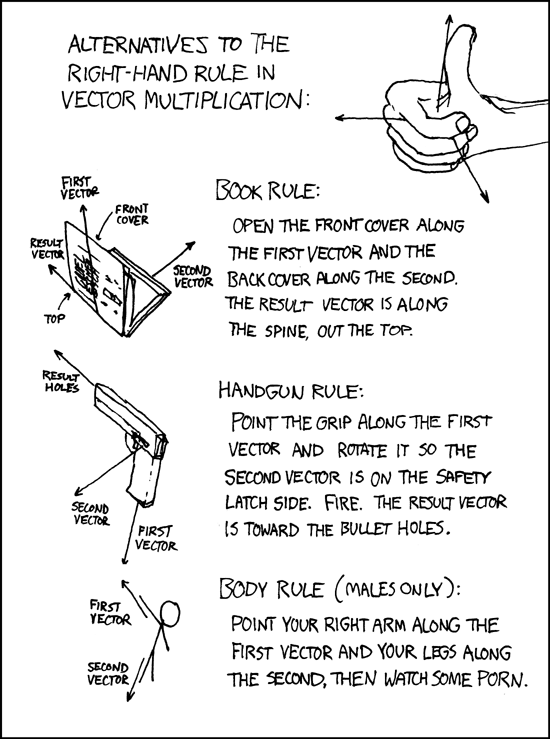199: Right-Hand Rule
| Right-Hand Rule |
 Title text: To really expand your mind try some noncartesian porn. Edwin Abbot Abbott has nothing on "Girls on Girls in Tightly Closed Nonorientable Spaces" |
Explanation[edit]
The right-hand rule is a mathematics and physics trick to learning how to find the cross product of two Cartesian vectors in three dimensions. First, extend the fingers of your right hand in the direction of the first vector (in the example diagram in the comic, this is to the left). Then, curl your fingers in the direction of the second vector (out of the page/screen, in the example). Now point your thumb perpendicular to the other fingers, and it will point in the direction of the cross product of those two vectors (upwards, in the example). Note that reversing the order of the two vectors also reverses the direction of the cross product.
The book rule is an actual alternative to the right hand rule that might be useful to some physics students doing exercises out of their textbooks. However, it would give incorrect results with books in languages that are read from right to left, such as most Jewish prayer books.
The gun rule also technically works, but it would be extremely impractical, expensive, and dangerous to use and fire a loaded gun every time you want to find the result vector. It would also be very awkward to hold the gun in line with the vectors. It also assumes that the safety latch is consistently on the same side of all guns; if a gun was made with the safety latch on the other side, then it would give incorrect results.
The body rule is described as for 'males only', which would limit the number of people who are able to use this rule. With the right arm oriented along one vector and the legs along the second, the result vector is found along the penis of a person who has one, which may be conveniently erected by watching porn.
The title text refers to Edwin Abbott Abbott, author of the book Flatland, a story about a two-dimensional world. Flatland is a recurring topic, such as in 721: Flatland. The title text misspells Abbott's name - unlike most typos in XKCD, this has not been corrected by Randall.
Orientability is a property that refers to a space with continuously varying surface normals, which are essentially just vectors that are perpendicular to the surface of the space. Nearly every space commonly encountered is orientable; this is likely why the porn is referred to as mind expanding and superior to Edwin Abbott Abbott's work.
Transcript[edit]
- [Picture of a right hand with fingers curved, thumb pointed away, with axes drawn to demonstrate the right-hand rule of physics.]
- Alternatives to the Right-Hand Rule in vector multiplication:
- [A slightly-open book with labeled axes drawn on.]
- Book Rule: Open the front cover along the first vector and the back cover along the second. The result vector is along the spine, out the top.
- [A handgun with axes.]
- Handgun Rule: Point the grip along the first vector and rotate it so that the second vector is on the safety latch side. Fire. The result vector is toward the bullet holes.
- [A person with right arm extended.]
- Body Rule (males only): Point your right arm along the first vector and your legs along the second, then watch some porn.
Discussion
There's also the right hand rule on urban dictionary, although it's applied slightly differently, and it only has one input parameter. Davidy22 (talk) 03:44, 30 October 2012 (UTC)
I expanded the explanation to cover the erection joke. 184.66.160.91 02:12, 27 August 2013 (UTC)
Can anyone explain "Girls on Girls in Tightly Closed Nonorientable Spaces"? What is that, lesbians in a box? What is a nonorientable space? Swordsmith (talk) 02:14, 28 November 2015 (UTC)
A non orientable space is, IIRC, a shape like a Möbius strip, in which has a sort of topological " handedness." Or maybe that's an orientable space. I'm pretty sure it's non orientable.
As far as noneuclidean porn goes though, I have a fetish for fractals. Just pull up a sexy fractal zoom and we're good to go. But I'm cisfemale. No dick. X'D International Space Station (talk) 09:18, 27 April 2016 (UTC)
It turns into a cat for me 108.162.218.166 (talk) (please sign your comments with ~~~~)
"Cross product", huh? Koro Neil (talk) 06:10, 27 December 2018 (UTC)
Am I missing something in the note "However, it would give incorrect results with books in languages that are read from right to left, as well as most Jewish prayer books."? In these books the terms front, back and top are still the same, no matter in which direction the letters go? Someone please explain to me why it makes a difference or delete that sentence. --Lupo (talk) 10:06, 27 September 2019 (UTC)
- Page order tends to follow text direction; in RTL languages, books are generally printed in what we would consider reverse order, with the spine to the right if the book is closed face-up. So, no, the terms front, back, and top are not the same, but exactly reversed, because the front is defined by where the book starts, not by how someone used to English books would hold it, and it starts on the other side from what we'd expect. The same goes for the other terms, and the result is that the book as depicted would be upside-down.Swolffs (talk) 10:01, 7 October 2019 (UTC)
